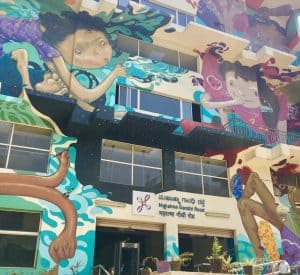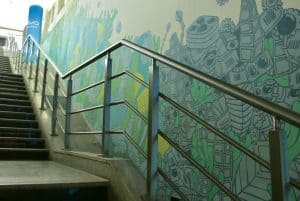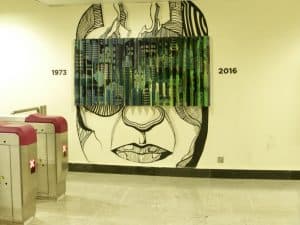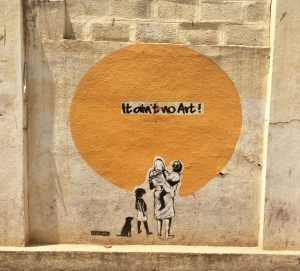
Mural painted by Harshvardhan Kadam and students of Srishti at MG Road Namma Metro Station (Church Street side). Photo by Alexander Sam Thomas

Mural painted By Students of Srishti at Cubbon Park Namma Metro Station. Photo By Alexander Sam Thomas
As soon as you exit the MG Road metro station on Church Street side, the whole wall is filled with murals of children laughing and playing. The sight leaves a huge smile on one’s face and is a testament to the astonishing artwork of Pune-based mural artist Harshvardhan Kadam and the students of Srishti School of Design.
Walking down the steps of the Cubbon Park metro station is a sight that is the exact opposite of what most people expect to find. The usual drab and dull walls of the station are painted with plants and flowers of varying colours and brightness.

Most of the murals seen on the walls of Namma Metro Station are the end results of the time and soul put in by the students at Srishti.
Murals are a type of street art that expresses the emotions of the artist or the society. Local artists like Ullas Hydoor, Amitabh Kumar, and ‘Guess Who’ have showcased their talents by painting the walls at St Marks road, Indiranagar, and Church Street. International artists like Marko 93, and Artez have pitched in with sweat and talent to make the walls of Bengaluru beautiful. Travelling around the busy city has become a sight for sore eyes; the credit goes to the collaborative work by these local and international geniuses.

A small work by anonymous artist ‘Guess Who’ at Church Street. Photo by Alexander Sam Thomas
Murals in Bengaluru are either the work of professional artists or are simply the plain outlet for the students with budding talents, who paint these walls to spread a message.
“We wanted to enliven the spirits of everyone taking the metro each day to get to their places of work. We hoped that these artworks at the station would somehow make the monotonous life of the Bengalureans, a tad brighter,” says Akshaya, an ex-Srishti student, who worked on art pieces at the Peenya Metro Station.
Bengaluru is always teeming with rich artwork and phenomenal artists but street art and murals have recently kicked up a new storm. The life in a fast-lane is accustomed to being impervious to the bleak, dirt-stained walls and pillars around. However, ever since artists from in and around the city have taken to the streets to beautify the walls, no busy life has stopped people from giving it all their appreciation.

Mural by International artist Marko 93 at Church street. Photo By Alexander Sam Thomas
Alexander Sam Thomas was a intern at the Co Media Lab this summer working on the Live Newsroom Programme.